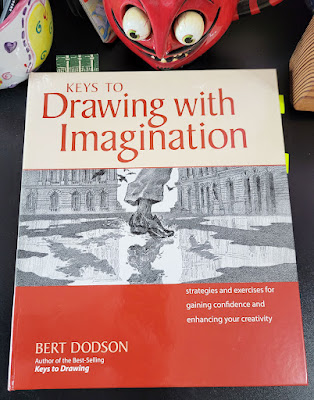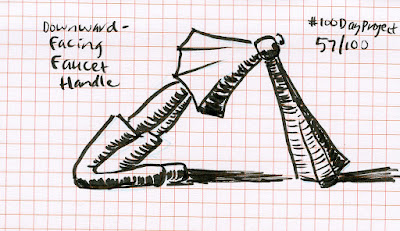 |
| An illuminating book on drawing from the imagination. |
Whenever I read a book I own, I write the date on the title
page. If I happen to re-read it, I write the successive dates, too. That’s
how I knew that I had read Danny Gregory’s The Creative License five
times.
The first time I read Bert Dodson’s Keys to Drawing with Imagination was in December 2011, only a few months after I had committed to learning to draw. Everything I read went way over my head. I could not get into any of the exercises – not for lack of desire or commitment, but it all seemed too hard. My second reading was in August 2020 when I became seriously interested in learning to draw from my imagination. I didn’t do many of the exercises, but reading it started to make more sense and encouraged me to keep trying. A few months later, I took a Gage workshop in using my sketchbook for something other than drawing from life, and those exercises helped me explore in ways that suited me better at the time.
A few days ago I remembered Keys to Drawing with Imagination again and started reading it for the third time. This time, I find myself repeatedly nodding to myself as I read because it all makes so much more sense – like this paragraph:
“Imagination is tightly linked to observation – a familiarity with how something actually looks makes it possible to imagine how it could look. While it is the goal of this book to help you with drawing the world as seen through imagination, there is no better way to develop the imaginative muscles than drawing from direct observation. Every time you draw from life, you strengthen the connection between your eye and your hand. These connections can be powerfully adapted to drawing the images you see in the mind’s eye.”
Didn’t I just say something like that myself? Obviously, I’m not discovering anything new here: Drawing from life is fundamental to drawing from imagination. And it’s no wonder that I got nothing from the book three months after I had begun to draw: I had no experience drawing from observation. How could I draw from my head without knowing how to draw from life? (Young children, of course, draw from their heads without ever drawing from observation, but most of us lose this ability eventually.)
After owning this book for more than 10 years, I realize that I am finally ready for it. It’s an irony of learning: Beginners (or at least this beginner) can only take in so much, even basic principles, without some degree of experience and practice. In fact, it’s a paradox: We can’t learn without practicing, but we don’t know how to practice without learning.
We’ve all heard that drawing is a skill, not an inherent “talent,” and therefore “anyone can learn to draw.” I absolutely believe that learning to draw requires no “talent.” It just takes commitment to deliberate practice and active learning (doing the work, not just viewing videos or reading). But I think we all hit a point at some stage in our practice when we see that we are not getting much better, so we get discouraged and quit. Maybe our brains are just not ready to learn more yet. Eventually, if we keep pushing and actively learning, the new learning starts showing in the results of our practice, and we step up to a new stage of development. The hard part, though, is pushing past that point instead of quitting.
I’m glad I didn’t get rid of Keys to Drawing with Imagination after my first reading. My series of drawings of a faucet handle with legs (without my intention, she seems to have taken on a life of her own) is the outcome of a couple of exercises Dodson recommends. I’m looking forward to doing more of the exercises.
(Dodson is also the author of Keys to Drawing, an excellent, classic how-to book on the fundamentals of drawing. Recommended.)







Like most things in life we need to be ready to absorb the lesson. Glad you still have the book to read again.
ReplyDeleteThat's true -- not just about books!
DeleteGreat post, Tina. And writing your read date in your books is genius. Wish I'd done that. I read and reread most of my art books. Each time I get something new from them for the reasons you mention...I'm further down the art road and have a different basis for evaluation of the material.
ReplyDeleteAll the more reason to buy books and keep them! ;-) (Oh no, my bookcases are already groaning from the weight!)
Delete